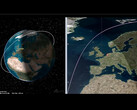Iris² is the European Union's third major satellite project after the GPS alternative Galileo and the earth observation project Copernicus. The aim is to establish an alternative to Starlink by 2030 that will guarantee member states of the European Union independent and secure access to the internet without being dependent on the whims of a billionaire or the political objectives of a foreign government.
According to Financial Times, a total of 10.6 billion euros will be invested in the project, 61% of which will come from the public sector and 39% from SpaceRise, an industrial consortium made up of Eutelsat, Hispasat, SES, Airbus and Deutsche Telekom, among others. SpaceRise has signed a twelve-year contract to build and operate the network. According to current plans, Iris² will consist of a total of 290 satellites, some of which will be placed in medium and some in low earth orbit.
Similarly to Starlink, the majority of the available bandwidth will be used to provide private individuals and companies with broadband internet, especially in areas with poor internet coverage. However, some of the capacity will also be reserved for governments in order to maintain critical infrastructure in the event of a crisis and to coordinate surveillance operations. So far, no further details are known about the expected bandwidth or the technology of the planned satellites.





















